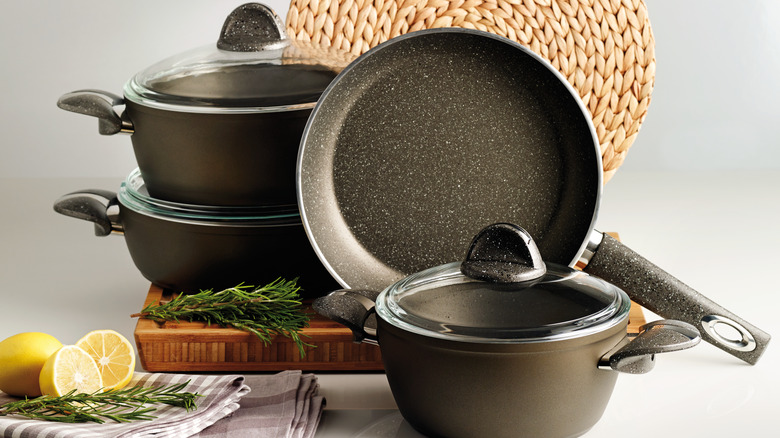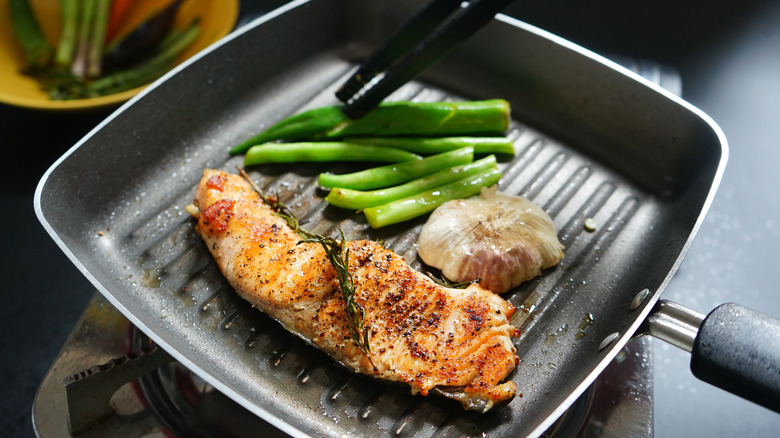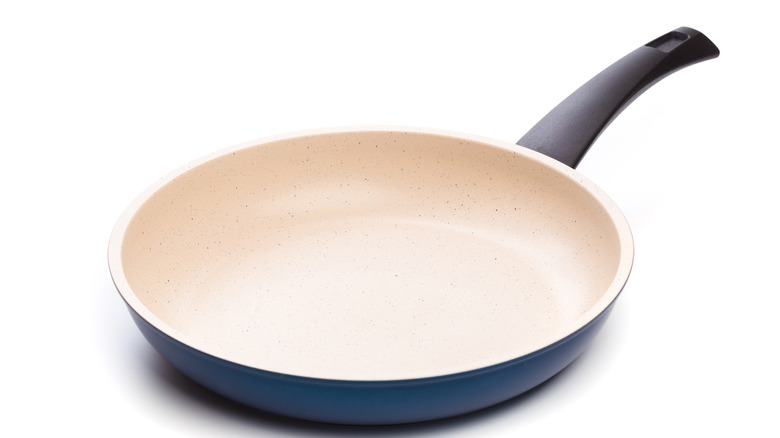What To Consider When Choosing Between Ceramic And Teflon Pans?
If you want to prepare the best foods, then you need the best equipment for the job. In any kitchen, one of the hardest workers will be a good set of pots and pans. There are a few dishes out there that won't require some ingredient to be seared, boiled, sauteed, or fried, which makes good cookware a necessity.
According to MasterClass, two of the most popular cookware options available today are ceramic-coated and Teflon-coated pots and pans. Teflon has been around for nearly 100 years and is one of the most common materials on the market. It's the brand name for a product known as polytetrafluoroethylene, which gives a non-stick coating to pots and pans.
CNET reports that the main problem with this material is that it was found to release perfluorooctanoic acid (PFOA), which was linked to cancer. Thankfully, PFOAs were removed from Teflon in 2013 to create a safer product, but its public relations were already hurting, and ceramic cookware was ready to swoop into its place.
SFGate explains that ceramic cookware is not made from clay like classic ceramic is. Instead, it is made from an aluminum body coated in a non-stick silicone gel. This gives it similar properties to Teflon's non-stick surface, but both materials still have many different pros and cons to consider when deciding what's best for you.
Chemicals coating the cookware
It would make sense to consider ceramic cookware the safer option of these two, but that isn't necessarily the case. MasterClass explains that ceramic cooking surfaces can still leach aluminum into foods when used over high temperatures. USA Today reports that aluminum leaching won't cause major health issues in healthy adults, but this is something that might still be a concern for more vulnerable populations such as the elderly and infants.
An easy solution is to avoid using your cookware over high heat; the same goes for teflon, per MasterClass. You should never dry heat non-stick cookware because overheating those materials can cause toxic fumes to be released into the air. Both of these materials are going to do their best work over medium heat rather than a high flame.
If your biggest concern is cooking a lot of steaks or meats that require a great sear, neither of these cookware options is going to be your best option. One of the best materials for searing meats is cast iron. Foodal notes cast iron retains heat better than most other cooking surfaces and only needs a few minutes over medium heat to provide a serious sear.
Durability of each surface
No one wants to pay a fortune for new cookware to replace it again in a couple of years. That's why it's important to consider the durability of these cooking surfaces before making a purchase. Prudent Reviews states that the typical lifespan of both materials is only about three to five years.
As Eat This, Not That! points out, you should never use metal utensils on non-stick cookware. Doing this will scratch away at the non-stick coating. Not only is there a possibility then of consuming the non-stick surface, but over time it will remove enough that your food will start sticking as well. MasterClass explains that ceramic cookware isn't immune from this drawback either. Both of these cooking surfaces are going to require silicone or wood utensils to ensure that they stay non-stick for as long as possible.
Made In adds that ceramic cookware (except for the highest quality) tends not to last long, either. Because the silicone coating creates a rough, uneven cooking surface to keep food from sticking, it also wears down quicker than other options. MasterClass also states that it isn't usually dishwasher or oven safe as well. It's also a bad idea to put Teflon in the dishwasher. Not only will the high heat wear out your surface, but the other dishes can cause scratches as well, per Pantry & Larder. SFGate and Only Cookware point out that both of these non-stick surfaces are thankfully easy to clean by hand, though.
Price
Any cook would love to always have the finest tools on the market, but the price may limit what's available to home chefs. Ceramic and Teflon cookware are no different. In this comparison, though, one of these products easily comes out on top in most scenarios. MasterClass points out that one of the drawbacks of ceramic cookware is its cost. While many of the other important considerations for these pans are fairly similar, more often than not, Teflon is going to be the more wallet-friendly option.
Prudent Reviews states that Teflon is more widely available and easier to make than ceramic cookware, which is how it takes a slight edge in this standoff. Of course, the price will vary widely depending on the brand, quality, and size of the cookware. Thankfully, Prudent Reviews also put together a comparison chart for many of the most widely available options on the market. But make no mistake: Both of these cookware options are still going to be less expensive than something like premium stainless steel. If cared for properly, they can also last a long time.



